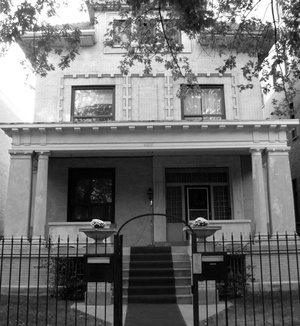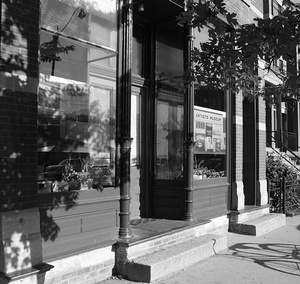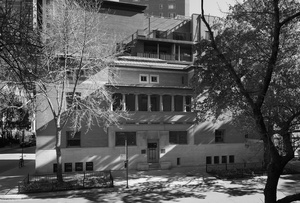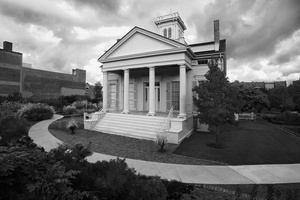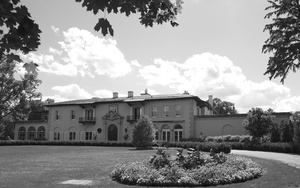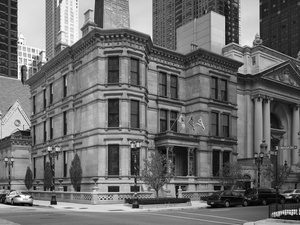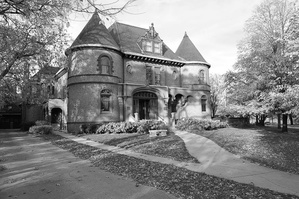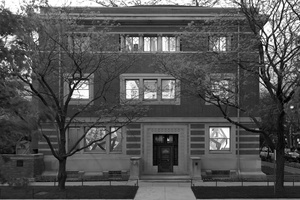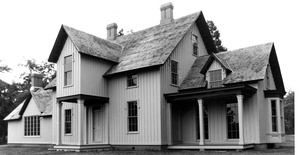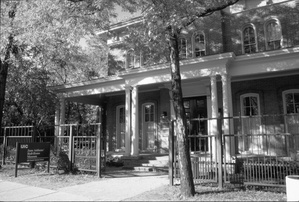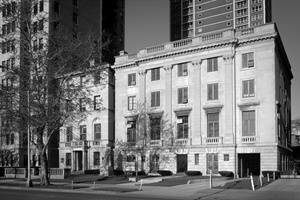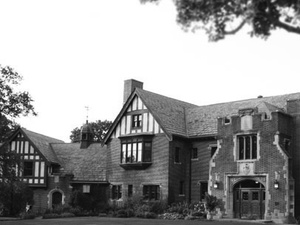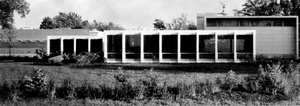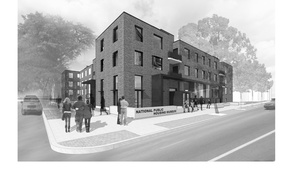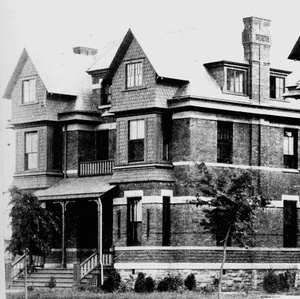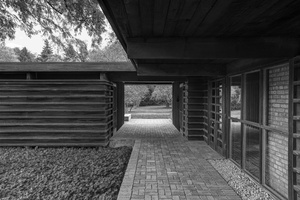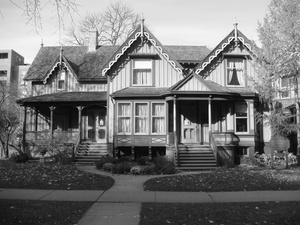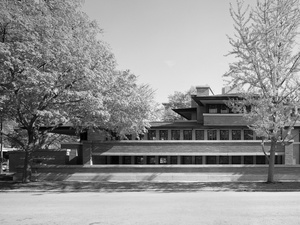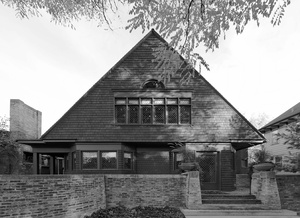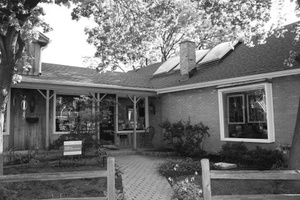In a dilapidated mansion on the North Side of Chicago in Edgewater, 6018North is an artist-centered platform and venue for experimental culture, performance, and art. 6018North challenges what art is, who it’s for, and where and how it’s created. It connects artists from multiple disciplines with each other and audiences by creating unforgettable experiences of art and engagement.
Built in 1938 for Adlai E. Stevenson II and his wife, Ellen Borden Stevenson, this modern Art Deco residence on a 70-acre estate served as Stevenson's residence until his death in 1965. During these years, Stevenson was the governor of Illinois, Democratic nominee for president in 1952 and 1956, and served as U.S. ambassador to the United Nations in the Kennedy Administration.
The Roger Brown Study Collection of the School of the Art Institute of Chicago is a place for object studies and wonder. Entering the collection, visitors are treated to a kaleidoscopic glimpse of things from many genres and origins, arranged by Brown as an artists' museum.
Designed in 1891, the Charnley-Persky House displays the combined talents of Louis H. Sullivan and his draftsman, Frank Lloyd Wright. The house is a culmination of Sullivan’s experiments with simplification of surface and mass that had evolved in his commercial work of the prior three years, and serves as a basis for Wright’s Prairie Style designs.
Clarke House Museum is the oldest surviving building in the original Chicago city limits and its only example of Greek Revival domestic architecture. Built in 1836 for hardware merchant Henry Brown Clarke and remodeled for his widow in the early 1850s, Clarke House Museum explores family life in pre-Civil War Chicago.
Built between 1914 and 1916, the Cuneo Mansion and Gardens is a beautifully preserved Italian Villa-style home. Originally built for Samuel Insull, the founder of Commonwealth Edison, the home was purchased in 1937 by John Cuneo, Sr. On display are the Cuneos’ European and American antiques, some hundreds of years old.
Steps away from Chicago’s Magnificent Mile, the Driehaus Museum offers visitors a fascinating view of one of the few remaining examples of the palatial homes erected by the wealthy of America’s Gilded Age. The lavish interiors are complemented by stunning examples of period furniture, decorative arts, stained glass, and period pieces selected from the Driehaus Collection. Visitors are immersed in the original splendor of this late 19th-century home.
This Queen Anne-style Victorian house was built in 1890 for Ernest Hemingway’s maternal grandparents. With a wraparound porch, elegant parlor, and meticulously restored architectural features, Hemingway’s boyhood home was the first residence in Oak Park to have electricity. It was also within walking distance of the trails and nature preserves that so inspired the author’s later work.
This National Historic Landmark mansion was home to 30th U.S. Vice President Charles Dawes and is now the Evanston History Center. The beautiful interior furnishings, artwork, and Tiffany lamps of the Dawes family combine with the architectural craftsmanship of architect Henry Edwards-Ficken to create an extraordinary and memorable experience.
Glessner House, a National Historic Landmark, is widely regarded as the urban residential masterpiece of architect H. H. Richardson. Completed in 1887, the imposing rusticated granite exterior conceals a warm and inviting interior filled with original furnishings and a private courtyard designed to bring abundant natural light into the rooms.
Founded in 1956, the Graham Foundation for Advanced Studies in the Fine Arts gives project-based grants to individuals and organizations, and produces public programs relating to architecture and its role in the arts, culture, and society. The Foundation—and its art galleries, bookstore, library of grantee publications, outdoor architectural fragments collection, and public programs—are located in the Madlener House, a turn-of-the-century Prairie-style mansion.
The Grove is a unique outdoor experience, with 143 acres of nature preserve dotted with historic buildings. The picturesque Kennicott House was built in 1856 by doctor and agriculturalist Dr. John A. Kennicott. Today, it’s a museum where docents offer hands-on activities and interpret The Grove’s human and natural history. The nearby Tudor-style Redfield Estate, built circa 1929 by a Kennicott descendent, is rentable for private gatherings.
The Jane Addams Hull-House Museum at the University of Illinois at Chicago serves as a dynamic memorial to social reformer Jane Addams, America’s first woman to win the Nobel Peace Prize. The museum is in two of the original settlement house buildings—the Hull Home, a National Historic Landmark, and the Residents' Dining Hall. Both have welcomed some of the world's most important thinkers, artists, and activists.
The International Museum of Surgical Science is the only museum in North America dedicated to the art and science of surgery. Housed in a historic mansion on Lake Shore Drive, four floors of exhibits interpret the ancient and modern healing practices of Eastern and Western civilizations, from acupuncture to X-rays.
Mayslake Hall was built in 1921 as the retirement home for Francis Stuyvesant Peabody of Peabody Coal, one of the nation’s largest coal producers. Its architect, Benjamin Marshall, was acclaimed for his historical revival designs, and Mayslake Hall is an outstanding example of Tudor Revival architecture. It now serves as an education and cultural center for the Forest Preserve District of DuPage County.
Elmhurst Art Museum is home to the McCormick House, one of only three residences in the United States designed by legendary mid-century architect Ludwig Mies van der Rohe. Built in 1952, the McCormick House offers a rare opportunity to experience his design philosophy, "less is more." The transformative changes in design and technical innovation of the 1950s reflect the architectural clarity and simplicity embraced by post-war American culture.
A National Historic Landmark, Pleasant Home is an opulent Oak Park mansion designed by Prairie School architect George W. Maher in 1897. The Arts and Crafts interior features art glass windows and intricate carved wood. In addition to being the only Maher residence open to the public as a museum, the home is also a popular location for performances, workshops, and classes.
The National Public Housing Museum is a one-of-a-kind cultural experience. On a historic public housing site in Chicago, the museum preserves a key chapter of our nation's history. Perspectives of residents and others at the heart of the public housing story, study, and conversation inspire youth, families, and the community to see opportunities where others saw only poverty. The site is currently undergoing restoration, and will be open to the public in the future.
The Town of Pullman was designed by architect Solon S. Beman in 1880 for the Pullman Palace Car Company. The housing included well-appointed executive homes and a wide range of row houses, apartments, and small flats for workers. Nearly 1,000 of the original housing units remain in Pullman and are privately owned. The Thomas Dunbar House, an executive house, is available for public tours by special arrangement.
Architect Paul Schweikher’s 1937 home and studio is a masterful integration of brick, glass, and wood, situated on seven and a half acres with gardens designed by the noted landscape architect Franz Lipp. Among its many features, the iconic Modernist home includes a massive brick fireplace, passive solar room, cantilevered construction, exposed wood beams, built-in furniture, Japanese soaking tub, and Zen Garden.
Established in 1900, the Frances Willard House Museum has a remarkably intact collection of original furnishings and objects, including furniture, artwork, textiles, family photographs, books, and a bicycle. Together, the house and collection tell the story of Frances Willard, one of the most prominent social reformers in 19th-century America and president of the Woman's Christian Temperance Union from 1879 to 1898.
The Frank Lloyd Wright Trust operates public tours, programs, and events at major Wright sites, three of which are historic houses: Wright’s Home and Studio (1889/1898) in Oak Park, the Frederick C. Robie House (1908-10) in Chicago’s Hyde Park, and the Emil Bach House (1915) in Chicago’s Rogers Park. The Trust’s other sites are public buildings, Unity Temple (1905-08) in Oak Park and The Rookery (1905-07) in downtown Chicago.
The Frank Lloyd Wright Trust operates public tours, programs, and events at major Wright sites, three of which are historic houses: Wright’s Home and Studio (1889/1898) in Oak Park, the Frederick C. Robie House (1908-10) in Chicago’s Hyde Park, and the Emil Bach House (1915) in Chicago’s Rogers Park. The Trust’s other sites are public buildings, Unity Temple (1905-08) in Oak Park and The Rookery (1905-07) in downtown Chicago.
Built in 1928, the Glasner Studio is Miller's most exquisite and rare gem of art, design, and architecture, "hidden in plain sight" in Chicago's historic Old Town neighborhood. Edgar Miller was a self-taught artist and master craftsman—a true “Renaissance Man” of the modern era—who transformed old buildings into modern works of livable art.
Studio & home of Alfonso Iannelli and his wife Margaret. After working on Midway Garden he settled in Park Ridge in 1919 and opened his doors to many great artists and architects. The Studio became a hub of creativity with many clients. Learn about Edgar Miller, Barry Bryne, Bruce Goff all of whom called Iannelli Studio their home.


























